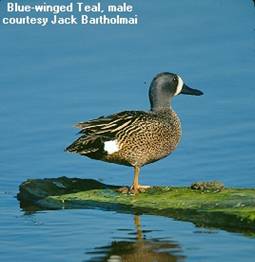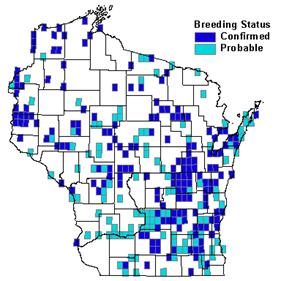

Status/Protection
- Global Rank: G5 Key to global and state ranks
- State Rank: S4B
- WBCI Priority: SGCN, State Special Concern
Population Information
The Federal BBS information can be obtained at http://www.mbr-pwrc.usgs.gov/bbs/bbs.html by clicking on Trend Estimates and selecting the species in question. All estimates are for time period (1966-2005).
- Federal Breeding Bird Survey: non-significant decline
- Federal Breeding Bird Survey (WI): significant decline
- Federal Breeding Bird Survey (BCR 23): significant decline
- Federal Breeding Bird Survey (BCR 12): non-significant decline
- Waterfowl Breeding Population and Habitat Survey: increase (USFWS 2006)
- Wisconsin Spring Duck Survey: decline (1973-2005)
- Nicolet National Forest Bird Survey (UWGB): decline (Howe and Roberts 2005)
- WSO Checklist Project: decline (1983-2007)
Life History
- Breeding Range: Alaska east across Canada and the northern half of the U.S. to the Atlantic coast.
- Breeding Habitat: Emergent Marsh, Inland Open Water, Northern Sedge Meadow and Marsh, Southern Sedge Meadow and Marsh, and Wild Rice.
- Nest: Ground; scrape typically located 30 cm above nearest water level (Rowher et al. 2002).
- Nesting Dates: Eggs: late April to mid-July (Robbins 1991).
- Foraging: Surface dips, dabbles (Ehrlich et al. 1988).
- Migrant Status: Short-distance migrant, Neotropical migrant.
- Habitat Use during Migration: Palustrine bottomlands, vegetated areas of lacustrine and palustrine wetlands, playa lakes, flooded rice fields, densely vegetated, clear water areas with high concentrations of desired invertebrates and seeds, marshes interspersed with emergent vegetation and open water.
- Arrival Dates: Late March to early May.
- Departure Dates: Mid-August to late October (Robbins 1991).
- Winter Range: Throughout Central and South America; also California and southern U.S. in smaller numbers (Rowher et al. 2002).
- Winter Habitat: Freshwater, intermediate, and brackish coastal wetlands, estuarine areas, open water areas with submerged vegetation and mangrove forests, shallow impoundments, mudflats and rice fields (Rowher et al. 2002).
Habitat Selection
Cattail and bulrush-rimmed marshes with permanent water and open, freshwater areas, including most lakes and artificial ponds, provide breeding habitat for Blue-winged Teal (March et al. 1973, Petersen et al. 1982, Evrard 2002). Important predictors of breeding habitat include water level, benthic invertebrate abundance, and the availability of undisturbed nesting cover adjacent to water (Rowher et al. 2002, Evrard 2002). Grasslands are the preferred nesting cover, but croplands also are used (Rowher et al. 2002). In Wisconsin, Blue-winged Teal prefer blocks of idle grassland, wet meadow wetlands, and active alfalfa fields (R. Gatti, pers. comm.). Nests are almost always located in upland habitats with residual cover from the prior year’s growth. Females seek high density stands of short to moderate grasses such as bluegrass, bromegrass, quackgrass, alfalfa, switchgrass, and other herbaceous vegetation (Bellrose 1976, Petersen et al. 1982, Wheeler et al. 1984, Rowher et al. 2002, Evrard 2002). Dense cover may increase nest density and nest success by reducing the effectiveness of predators (Petersen et al. 1982, Wheeler et al. 1984), but more study is needed (Jimenez and Conover 2001).
Pairs mostly use temporary and seasonal wetlands in early spring, but later shift to semi-permanent wetlands (Rowher et al. 2002). Flooded fields and temporary wetlands likely are used in response to food availability (Evrard 2002). During migration Blue-winged Teal use shallow water areas with submersed aquatic plants and good growth of moist soil plants along exposed shorelines (Jahn and Hunt 1964).
Habitat Availability
The amount and quality of undisturbed upland and wetland habitats in Wisconsin is limited. Prior to Euro-American settlement, wetlands occupied an estimated four million hectares of the total fourteen million hectares of Wisconsin’s land area. Today, 53% (2.1 million hectares) of these wetland habitats remain. Intensive agriculture and urban development have caused major long-term losses in secure nesting cover (WDNR 1992) and forced Blue-winged Teal to nest with greater frequency in alfalfa fields. Early harvesting of these croplands may result in nest loss and hen mortality and have serious conservation implications (Petersen et al. 1982, WDNR 1992). Fortunately, efforts are underway to address these losses. The Conservation Reserve Program (CRP) and other set-aside acreages have increased upland cover in recent years (WDNR 1992) and provided secure nesting habitat. Strict wetland use regulations and incentive programs designed to restore or enhance wetlands have helped to curb habitat loss and protect existing wetlands (WDNR 1995). Additionally, the Upper Mississippi River/Great Lakes Region Joint Venture has protected, enhanced, or restored more than 51,000 hectares of upland habitat in Wisconsin as well as 37,000 hectares of wetland habitat.
Population Concerns
Blue-winged Teal populations fluctuate greatly depending on wetland conditions in the prairie pothole region (Rowher et al. 2002). Waterfowl Breeding Population and Habitat Surveys in 2006 suggested a 28% increase in Blue-winged Teal abundance relative to 2005 and an increase of 30% compared to the 1955-2005 average (USFWS 2006). It is a common summer resident throughout Wisconsin (Jahn and Hunt 1964, Gostomski 2006) but the highest concentration occurs in the Rock and Fox river valleys in the southeast and prairie pothole region to the northwest (Robbins 1991). Blue-winged Teal were confirmed breeding in approximately 15% of the quads surveyed for the Wisconsin Breeding Bird Atlas (Gostomski 2006).
Harvest of Blue-winged Teal is relatively low in Canada and controlled in the U.S. by altering annual hunting season regulations in response to annual spring breeding survey estimates and is therefore not expected to have a negative impact on spring populations (Rowher et al. 2002). However, accurate estimates of harvest in Central and South America are unavailable and there are suggestions that harvest may be substantial. Fire suppression and intensive agriculture result in a long-term reduction in suitable grassy nesting habitat preferred by Blue-winged Teal (Jahn and Hunt 1964, March et al. 1973). High nest predation may impact some local populations. Raccoons, striped skunks, foxes, badgers, ground squirrels, and fox snakes are important predators in some areas (Wheeler et al. 1984, Rowher et al. 2002, Evrard 2002). Disease and parasites also may impact Blue-winged Teals. Individuals at Horicon Marsh have been susceptible to the following: Clostridium botulinum, Cestoda (Hymenolepius megalops), Acanthocephala, and Hemaproteus spp. (Jahn and Hunt 1964).
Recommended Management
Management efforts should focus on protecting remaining grasslands, particularly in those areas where numerous wetlands exist. Managers should consider establishing idle grasslands adjacent to existing wetlands to provide nesting cover. The recommended patch size for a nesting area is 32-40 ha, preferably in a square-like configuration (Petersen et al. 1982). However, landscape-level programs such as CRP may be more meaningful than actions that focus only on increasing nesting habitat patch size (Reynolds et al. 2001). Maintenance of optimal nesting habitat may require active management, e.g., allowing dead vegetation to accumulate and periodic burning, mowing, or grazing to prevent it from becoming too dense. Wetland restoration and enhancement efforts are needed in Wisconsin, particularly in agriculture-dominated landscapes (WNDR 2005). Wetland drawdowns that encourage growth of mudflat annuals, regenerate stands of emergent vegetation, stimulate primary productivity, and in turn improve the detrital base should benefit Blue-winged Teal (Kenow and Rusch 1996).
Although the vast majority of Blue-winged Teal utilize private lands and wetlands for breeding and migration, many public properties have secured key wetland bases (March et al. 1973, Petersen et al. 1982). Public lands of most importance for breeding and migrating Blue-winged Teal include the Upper Mississippi River NWR, Trempealeau NWR, Crex Meadows/Fish Lake complex, Necedah NWR, Horicon Marsh and Meadow Valley Wildlife Area (Jahn and Hunt 1964, March et al. 1973, WDNR 1992).
Research Needs
More information is needed on the wintering ecology and harvest of this species south of the U.S. border. Botero and Rusch (1988) suggest that the Neotropics are important wintering areas for Blue-winged Teal, but low band-reporting rates under-estimate the magnitude of their hunting mortality there. Few studies have occurred outside of the U.S. breeding grounds. Management practices that enhance production need further study (Rowher et al. 2002), along with whether dense cover actually improves nesting success (Jimenez and Conover 2001). Current Wisconsin research is attempting to elucidate the causal factors of this species’ decline in the state and concomitant increase in Mallard populations (R. Gatti, pers. comm.).
Information Sources
- Jahn, L.R. and R.A. Hunt. 1964. Duck and coot ecology and management in Wisconsin. Technical Bulletin (33):1-212. Wisconsin Department of Natural Resources, Madison.
- North American Breeding Bird Survey: http://www.mbr-pwrc.usgs.gov/bbs/bbs.htm
- Temple, S.A., J.R. Cary, and R. Rolley. 1997. Wisconsin Birds: A Seasonal and Geographic Guide. Wisconsin Society of Ornithology and Wisconsin Department of Natural Resources, Madison, WI.
- Wisconsin Breeding Bird Atlas http://www.uwgb.edu/birds/wbba/
- Wisconsin Department of Natural Resources (WDNR). 1992. Upper Mississippi River and Great Lakes region joint venture – Wisconsin plan. Madison, WI.
References
- Bellrose, F.C. 1976. Ducks, geese, and swans of North America. Stackpole Books, Harrisburg, PA.
- Botero, J.E. and D.H. Rusch. 1988. Recoveries of North American waterfowl in the neotropics. Pp. 469-482 in Waterfowl in Winter, M.W. Weller ed. University of Minnesota Press, Minneapolis.
- Ehrlich, P.R., D.S. Dobkin, and D. Wheye. 1988. The birders handbook: a field guide to the natural history of North American birds. Simon & Schuster, Inc. New York.
- Evrard, J.O. 2002. Duck production and harvest in St. Croix and Polk counties, Wisconsin. Technical Bulletin (194): 1-38. Wisconsin Department of Natural Resources, Madison.
- Gostomski, T. 2006. Blue-winged Teal. In The Wisconsin Breeding Bird Atlas (N.J. Cutright, B.R Harriman, R.W Howe, eds.) The University of Wisconsin Press: Madison, WI.
- Howe, R.W. and L.J. Roberts. 2005. Sixteen years of habitat-based bird monitoring in the Nicolet National Forest. In C.J. Ralph and T.D. Rich, editors. Bird Conservation Implementation and Integration in the Americas: Proceedings of the Third International Partners in Flight Conference. 2002 March 20-24; Asilomar, California, Volume 2. Gen. Tech. Rep. PSW-GTR-191. Albany, CA: Pacific Southwest Research Station, Forest Service, U.S. Department of Agriculture; 643 p.
- Jahn L.R. and R.A. Hunt. 1964. Duck and coot ecology and management in Wisconsin. Technical Bulletin (33): 1-212. Wisconsin Department of Natural Resources, Madison.
- Jiménez, J.E and M.R. Conover. 2001. Ecological approaches to reduce predation on ground-nesting gamebirds and their nests. Wildlife Society Bulletin 29(1): 62-69. 2001.
- Johnson, D.H. and J.W. Grier. 1988. Determinants of breeding distributions of ducks. Wildl. Monogr. No. 100.
- Kenow, K.P. and D.H. Rusch. 1996. Food habits of Redheads at the Horicon Marsh, Wisconsin. J. Field Ornithol. 67(4): 649-659.
- Longcore, J.R., D.G. McAuley, G.R. Hepp, and J.M. Rhymer. 2000. American Black Duck (Anas rubripes). In The Birds of North America, No. 481 (A. Poole and F. Gill, eds.). The Birds of North America, Inc., Philadelphia, PA.
- March, J.R., G.F. Martz, and R.A. Hunt. 1973. Breeding duck populations and habitat in Wisconsin. Technical Bulletin (68): 1-36. Wisconsin Department of Natural Resources, Madison.
- Petersen, L.R., M.A. Martin, J.M. Cole, J.R. March, and C.M. Pils. 1982. Evaluation of waterfowl production areas in Wisconsin. Technical Bulletin (135): 1-32. Wisconsin Department of Natural Resources, Madison.
- Robbins, S.D., Jr. 1991. Wisconsin birdlife: Population and distribution past and present. Madison, WI: Univ. Wisconsin Press.
- Reynolds, R.E., T.L. Shaffer, R.W. Renner, W.E. Newton, B.D.J. Batt, and B.D. Batt. 2001. Impact of the Conservation Reserve Program on duck recruitment in the U.S. Prairie Pothole Region. Journal of Wildlife Management 65(4): 765-780.
- Rowher, F.C., W.P. Johnson, and E.R. Loos. 2002. Blue-winged Teal (Anas discors). In The Birds of North America, No. 625 (A. Poole and F. Gill, eds.). The Birds of North America, Inc., Philadelphia, PA.
- United States Fish and Wildlife Service (USFWS). 2006. Waterfowl population status, 2006. U.S. Department of the Interior, Washington, D.C. U.S.A.
- Wheeler, W.E., R.C. Gatti, and G.A. Bartelt. 1984. Duck breeding ecology and harvest characteristics on Grand River Marsh wildlife area. Technical Bulletin (145): 1-49. Wisconsin Department of Natural Resources, Madison.
- Wisconsin Department of Natural Resources (WDNR). 1992. Upper Mississippi River and Great Lakes region joint venture- Wisconsin plan. Madison, WI.
- Wisconsin Department of Natural Resources (WDNR). 2005. Wisconsin’s Strategy for Wildlife Species of Greatest Conservation Need. Madison, WI.
Contact Information
- Compiler: Steven C. Houdek, steve_houdek@usgs.gov
- Editor: Kim Kreitinger, K.Kreitinger@gmail.com
